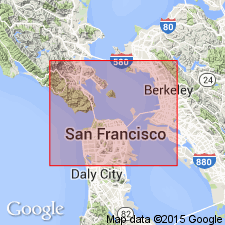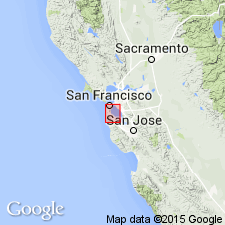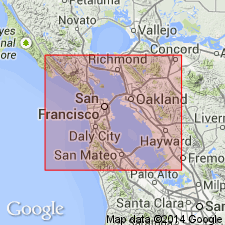
- Usage in publication:
-
- San Francisco sandstone
- Modifications:
-
- Original reference
- AAPG geologic province:
-
- Santa Cruz basin
Summary:
Pg. 145-156 (Geology of the vicinity of San Francisco, Chap. XII). Fine-grained compact sandstones associated with thin shales. Thickness 1,000 to 3,000 feet. Tertiary in part at least, but Upper Cretaceous may also be represented. Forms greater part of hills and mountains around the [San Francisco] bay and, so far as explored, a considerable part of mass of Coast Mountains. Believed to be most extensive and highly developed sedimentary formation of California coast, and may appropriately be known as San Francisco or California sandstone. [Includes sandstones of Franciscan group and rocks belonging to Merced formation.]
Source: US geologic names lexicon (USGS Bull. 896, p. 1910-1911).

- Usage in publication:
-
- San Francisco sandstone
- Modifications:
-
- Revised
- AAPG geologic province:
-
- Santa Cruz basin
Summary:
Pg. 417; Amer. Geol., v. 15, p. 347, 1895. San Francisco sandstone, the dominant sedimentary formation of Franciscan series, consists of moderately fine-grained sandstone with subordinate beds of shale and conglomerate. Is interbedded with foraminiferal limestones, radiolarian cherts, and volcanic rocks, including basaltic lavas, diabases, pyroclastic accumulations, etc.
Source: US geologic names lexicon (USGS Bull. 896, p. 1910-1911).

- Usage in publication:
-
- San Francisco sandstone
- Modifications:
-
- [Abandoned]
- AAPG geologic province:
-
- Santa Cruz basin
Summary:
Divided Franciscan rocks into five named formations, three of which are sandstone.
[GNC remark (ca. 1936, US geologic names lexicon, USGS Bull. 896, p. 1910-1911): The term "San Francisco sandstone" is no longer used by geologists.]
Source: US geologic names lexicon (USGS Bull. 896, p. 1910-1911).
For more information, please contact Nancy Stamm, Geologic Names Committee Secretary.
Asterisk (*) indicates published by U.S. Geological Survey authors.
"No current usage" (†) implies that a name has been abandoned or has fallen into disuse. Former usage and, if known, replacement name given in parentheses ( ).
Slash (/) indicates name conflicts with nomenclatural guidelines (CSN, 1933; ACSN, 1961, 1970; NACSN, 1983, 2005, 2021). May be explained within brackets ([ ]).

